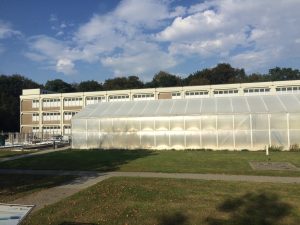 At the first excursion of the 2016 greenXchange program, 28 young professionals from Israel and Germany visited the Forschungszentrum Jülich (Jülich Research Center – FZJ). The FZJ is part of the Helmholtz Association of German Research Centers, the largest scientific organization in Germany. Forschungszentrum Jülich was founded in 1956 as an "atomic research establishment" by the state parliament of North Rhine-Westphalia (NRW). Nowadays the research center with an annual revenue of over half a billion Euros is funded by the German Federal government, the state government of North Rhine-Westphalia and third party collaborations and research grants.
At the first excursion of the 2016 greenXchange program, 28 young professionals from Israel and Germany visited the Forschungszentrum Jülich (Jülich Research Center – FZJ). The FZJ is part of the Helmholtz Association of German Research Centers, the largest scientific organization in Germany. Forschungszentrum Jülich was founded in 1956 as an "atomic research establishment" by the state parliament of North Rhine-Westphalia (NRW). Nowadays the research center with an annual revenue of over half a billion Euros is funded by the German Federal government, the state government of North Rhine-Westphalia and third party collaborations and research grants.
During their tour, the participants received an introduction into the research that is done at FZJ and can be clustered into two themes: energy and environment, and information and the brain. The introduction was followed by a discussion about international cooperation at FZJ and new technologies that have been developed at the center. Participants were particularly impressed by the plethora of high-tech applications that have resulted from basic research such as environmental sensors, a supercomputer, and brain electrodes to treat conditions like tinnitus.
The focus of the second part of the visit was to learn more about the research environment and the current state of two projects at the intersection at bioeconomy and biotechnology: the cultivation of algae for bio-jet fuels and tools for soil analysis.
 The cultivation of algae for the production of jet fuels takes place at the Plant Sciences division of the Institute of Bio- and Geosciences. Doctoral researcher Charlotte Dietrich explained her research to the participants and introduced them to the cultivation facilities including proprietary technologies at FZJ, such as high-tech seeding robots and novel phenotyping systems using rhizotrons for tracking plant root development non-invasively.
The cultivation of algae for the production of jet fuels takes place at the Plant Sciences division of the Institute of Bio- and Geosciences. Doctoral researcher Charlotte Dietrich explained her research to the participants and introduced them to the cultivation facilities including proprietary technologies at FZJ, such as high-tech seeding robots and novel phenotyping systems using rhizotrons for tracking plant root development non-invasively.
Doctoral researcher Anne Klosterhalfen explained tools for soil analysis of the IBG-3 modeling project that have been developed to measure a wide set of parameters of soil properties to understand how to improve the soil to a maximum of efficiency for plant cultivation. The “HPSC” and “lysimeter” machines measure soil quality, the flux of water and CO-2 content, and thereby help researchers to establish an understanding to soil preservation. In the future, agronomists will be able to optimize their crop selection according to soil quality and adapt it to climate change.
Forschungszentrum Jülich inspired greenXchange participants to further improve their knowledge about the current state of basic research in bioscience and to look for opportunities of cooperation between scientific research institutions and the greenXchange network with the aim of introducing innovative technologies for sustainability.